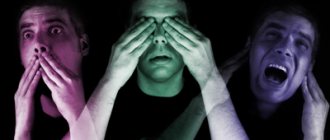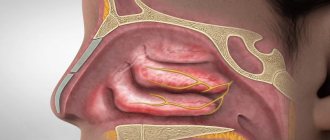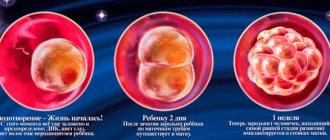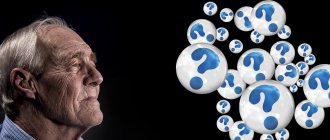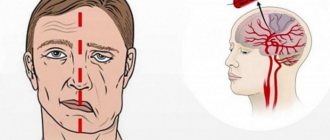Schizophrenia is a fairly common mental illness. It is manifested by disturbances in thinking, perception, emotional-volitional disorders and inappropriate behavior. The term “schizophrenia” was proposed by the Swiss psychopathologist E. Bleuler. Literally it means “splitting of the mind” (from the ancient Greek words “σχίζω” - split and “φρήν” - reason, mind).
Historical information about schizophrenia
The first information about schizophrenia-like symptoms dates back to 2000 BC. From time to time, many prominent physicians from different eras also described similar psychotic disorders. In his work “The Medical Canon,” Avicenna spoke about severe madness, partly reminiscent of schizophrenia. Pathology began to be studied in more detail only at the end of the 19th century. The German psychiatrist E. Kraepelin (1856-1926) observed adolescent patients suffering from various psychoses. In the process of research, he found that after some time all patients developed a similar state of special dementia. It was called “dementia praecox” (dementia praecox). Other psychiatrists supplemented and expanded information about the symptoms, course and outcomes of this disease. At the beginning of the twentieth century, the Swiss psychopathologist E. Bleuler proposed introducing a new name for the disease - “schizophrenia”. He proved that pathology occurs not only at a young age, but also in adulthood. Its characteristic feature is not dementia, but a “violation of the unity” of the psyche. The proposed concept of schizophrenia was recognized by all psychiatrists.
Why does schizophrenia develop?
Despite the high level of development of modern medicine, it has still not been possible to establish the exact cause of this disease. Psychiatrists are more inclined to the genetic theory of the occurrence of schizophrenia. It says: if there is a person with schizophrenia in the family, then his blood relatives have a high risk of developing this pathology. However, the mode of inheritance and molecular genetic basis of the disease are unknown. An important role in the development of schizophrenia is played by personality traits, low social status (poverty, poor living conditions, dysfunctional family, etc.), various diseases (drug addiction, alcoholism, chronic somatic pathologies, traumatic brain injuries, prolonged psychotraumatic situations, etc.) Sometimes The onset of schizophrenia is preceded by stress, but in most patients schizophrenia occurs “spontaneously.”
Schizophrenia
The term “schizophrenia” (splitting of the soul) was proposed by E. Bleuler in 1911. Its author believed that disorder, inconsistency and inconsistency of mental processes is the main characteristic of the disease.
The general theory of “dementia praecox” by E. Kraepelin was quite fatalistic, asserting the purely hereditary origin of the disease, its early onset and the rapid onset of deep and irreversible dementia. E. Kraepelin himself subsequently changed his views, but in the eyes of the average person, schizophrenia is still a terrifying disease. Many psychiatrists are still not inclined to identify more favorable forms of the disease with schizophrenia, based either on dubious, controversial considerations, or resorting to gene fetishism, absolutizing the course and frequency of inheritance of diseases that are supposedly independent of schizophrenia. As E.K. Krasnushkin said, they divide one large nebula into several smaller ones.
Epidemiology of schizophrenia. The prevalence of the disease in humans ranges from 0.77% to 1.5% (there is data - up to 2%), equally affecting both men and women; the given figures relate to the manifest (developed) forms of the disease. These figures could increase significantly if “schizophrenia spectrum disorders” were taken into account (“schizotypal personality disorder”, “borderline personality disorder”, “schizoaffective disorders”, “atypical psychoses”, “delusional psychoses”, some psychopathy of procedural origin).
| | Where and how to treat schizophrenia? |
Epidemiological data date back to the second half of the twentieth century; previously such studies had not been carried out on a mass scale. Therefore, it is impossible to say whether the morbidity of schizophrenia is increasing, decreasing, or remaining unchanged. The incidence of schizophrenia (the number of newly identified cases of the disease in one year) in different countries varies from 0.11 to 0.7 cases per 1 thousand population, but this indicator is relative. The morbidity and incidence of schizophrenia is slightly higher in the urban than in the rural population, but this difference may be due to the availability of psychiatric care and cultural differences.
The prevalence of the disease is higher in lower socioeconomic strata of the population, which is not least due to the social drift of patients. Patients from the “highest circles” of society may not be included in official statistics at all. Schizophrenia most often occurs between 15 and 35 years of age. In 50% of cases, the onset of the disease is recorded before the age of 25 years. In adolescents, the disease is first registered 10 times less often, and in children - 100 times less often than in mature patients. The manifestation of the disease occurs much less frequently after the age of 40, during the period of involution, and even more so in old age.
Etiology of schizophrenia. Currently, there are two main theories of etiology: genetic and psychogenetic. The role of hereditary factors in general is quite large, as evidenced by data from studies on twins, as well as cases of accumulation of the disease in blood relatives. It is especially great in cases of early onset and with a malignant course of the disease. It is possible, however, to have a hereditary predisposition to the disease and still remain a healthy person.
This means that other pathogenic influences (constitution, physical and mental trauma, hormonal and other disorders) that can have a significant impact on the penetrance and expressivity of abnormal genes have an important causal role in the development of the disease. The mode of transmission of genetic predisposition to schizophrenia has not been established. The polygenic theory of inheritance is considered preferable.
It is assumed that the “schizophrenic genome” has up to 11 genes scattered across different autosomes. It is also known that the disease manifests itself earlier in descending generations and is more severe. Healthy carriers of “schizophrenic” genes, as some authors believe, often have more developed adaptive capabilities, from which it can be concluded that schizophrenia is the price to pay for human biological progress. Carriage of genes in many cases can be determined by the mental qualities of relatives and deviations in character.
Psychogenetic theories of the etiology of schizophrenia are heterogeneous. One of them, going back to psychoanalysis, considers schizophrenia to be the result of disrupted interpersonal relationships in the family, when the child falls into the trap of conflicting demands from the mother. The child thereby loses the ability to recognize the logic of thinking, distinguish nuances in relation to himself, be aware of his motives and see the differences between hidden and obvious meanings. Psychoanalysts call such a mother “schizophrenogenic.” Supporters of behaviorism, for whom a person is the sum of skills and habits, believe that schizophrenia is not a disease, but a set of “bad” habits, from which the patient can be freed through special training. Representatives of existentialist psychiatry see in schizophrenia the escape of the individual from a hostile world and a special form of individual existence.
Finally, supporters of the infectious theory consider “slow viruses” to be the cause of the development of schizophrenia. This, in their opinion, is indicated by gliosis, glial scars and antibodies to viruses in the blood serum and cerebrospinal fluid.
| | You can find out the most detailed information about schizophrenia from the book of Professor Vitaly Leonidovich Minutko |
Pathogenesis of schizophrenia. The currently prevailing theory of pathogenesis boils down mainly to the fact that disturbances in the activity of psychophysiological structures, and thereby mental dysfunction, are based on hyperproduction of neurotransmitters or hypersensitivity to them on the part of the corresponding receptors of the postsynaptic cleft. The dynamics of such neurotransmitters as dopamine, norepinephrine, serotonin, glutamic acid, gamma-aminobutyric acid, endorphins, enkephalins, as well as modifications of endogenous amines that have psychotomimetic properties have been especially actively studied in recent decades.
The data obtained are quite contradictory and cannot be interpreted unambiguously.
Firstly, it is not always possible to say that these changes are exclusively pathogenic in nature and are not associated with an inadequate response of brain protection.
Secondly, there are significantly more neurotransmitters than those mentioned - now there are more than three dozen of them. Little is actually known about the role of most of them.
Thirdly, the available information about disorders of neuromediation and the functions of the corresponding brain structures is not of any systemic nature - we are talking about particulars that do not make up any holistic picture. In addition, similar, close or even identical changes in neurotransmission occur in other diseases. To this we can add that modern psychopharmacotherapy is not so impressive in its results, if you do not keep in mind the symptomatic effect, and its long-term consequences have actually been poorly studied and not properly assessed.
It is believed that the psychopharmacological era of treatment of schizophrenia is coming to an end, and expectations are growing for the emergence of fundamentally new approaches to the treatment of psychiatric pathology. Psychogenetic theories of pathogenesis exist and develop, as S. Freud said, without regard to the brain. At the same time, the activity of certain psychodynamic forces is postulated, entering into complex relationships with each other. For example, K. Rogers sincerely hoped for high results in the treatment of schizophrenia with the help of the groups of meetings he proposed that stimulate the development of self-awareness. It can be considered established that psychotherapy for schizophrenia has not previously and is unlikely to have the significance of a method that justifies radical hopes.
Symptom complex of schizophrenia. The painful experiences of patients with schizophrenia are so diverse and can be presented so differently in patients that it is almost impossible to find two identical patients. The exception is patients with deep mental defects, individual differences between whom are often erased to the ground. It is much easier to say what mental disorders do not occur in schizophrenia. This is an organic decrease in attention, memory, thinking and intelligence, personality. There is no stupor, delirious and twilight stupefaction and epileptic seizures. Of course, such disorders also occur in patients with schizophrenia, but they have other causes, mostly associated with some intercurrent disease. We do not set out here the task of a complete and detailed description of all the symptoms of schizophrenia. Below we will describe only those disorders that are more or less likely to indicate the presence of this disease.
Personality changes. Although they fluctuate in a very wide range - from subjectively determined deviations to deep regression and even dementia - they always contain or can be discerned something unique that is not characteristic of other diseases or, if such features are present, then nothing more than a superficial analogy. The essence of personality changes in schizophrenia is characterized by their totality in relation to the world, society, people and to oneself. It includes:
1. The disintegration of the unity of personality into a number (many) functional subunits or subpersonalities, little connected in their activity with each other. The same patient may behave quite adequately and even rationally for some time, but at other times or at certain moments - strange, absurd, absurd. In a conversation with a doctor, he can make the most favorable impression on the latter, but as soon as he leaves the office, he becomes unrecognizable, committing shocking actions to those around him or speaking in a very unusual way, previously unusual for him.
The absence of a definite and stable line of behavior makes patients in the eyes of others unpredictable, impulsive, acting on some random impulse or under the influence of a fleeting impression. A very typical formula for personality disintegration is the duality of motives, thoughts, feelings, emotions and self-awareness, but the matter is often not limited to this. Patients can simultaneously or alternately coexist in the real and imaginary worlds, and the imaginary worlds easily replace each other. The loss of the integrative principle also leads to the fact that impulses, desires, thoughts, feelings, and the expressive sphere function as if autonomously, automatically, independently of each other.
2. Introversion - the growing attention of patients to the phenomena of internal, primarily unconscious life: dreams, fantasies, dreams, ideas far from reality, premonitions, insights. During a period of prolonged crisis, K. Jung, for example, was completely absorbed in his strange dreams, daydreams, and visions, finding himself detached from reality. Evidence of apparent consciousness does not attract the interest of patients as it once did.
Perhaps this occurs due to hypotension of consciousness and emptiness of the latter, as suggested by J. Berre (1914). As one of the writers noted, monsters do not live in the light, they appear in the fading light of consciousness. A tense anti-entropic and productive conscious life requires enormous energy expenditure, which patients are too often unable to endure. The other side of painful introversion lies in inattention to the real aspects of life. This is often called contemplation, absent-mindedness, lack of concentration, but these are just general words that do not capture the essence of the problem. Finally, introversion in its extremely painful form is also manifested in the persistent attention that is associated in patients with personalized phenomena of the unconscious. This is especially true for deceptions of perception and delusional ideas.
3. Autism is a personality disorder, perhaps the most important distinctive feature of which is the replacement of objective reality with subjective reality. What is desired, expected, or feared is accepted by the patient as a fait accompli, even if there is no tangible evidence for this. Autism is a departure from the real world into the virtual world, and the latter often seems to the patient to be incomparably more realistic and relevant than the most obvious reality.
4. Disintegration of interpersonal communications. Social isolation, isolation from others, secrecy increase, and trusting relationships disappear. People whose internal agents are subjective ideas about them lose their former power of influence, lose their charm, attractiveness, friendliness, and tender feelings. The sphere of attachments suffers greatly. Close people are increasingly moving away and are perceived as strangers, friendships are severed, if they existed at all, the circle of friends and in general people who previously aroused sympathy, respect, and compassion are narrowing.
Communication with people becomes burdensome, formal, soulless, dry, and it is easily, without regret or remorse, interrupted until the next time when some official need arises. There are, however, patients who do not maintain a distance of decency even with strangers, communicating with them as with intimate friends, in an intimate manner, and open to extremely inappropriate nudity. In communicating with most people, patients reveal barely hidden wariness, distrust, hostility, not to say hostility.
The human world seems sick, full of uncertainty, danger, obvious and hidden threats. Sometimes there seems to be some reason for this (offensive, caustic remarks, ridicule, separation, artificially created obstacles in study and career advancement), but the main reason for this perception of people is, most likely, the patients’ growing own aggressiveness, latent hatred of people and to society - the mechanism of formation of the feeling of hostility of the world by S. Freud was explained by the intricate process of projection. In reality, everything happens, apparently, much simpler: an egocentric nature, and the egocentrism of patients is well known, usually believes that others think like herself, being unable to accept the principle of sociality in relations to herself and others.
5. The sphere of interests, hobbies, tastes, habits, and preferred activities undergoes very significant changes. Sometimes it happens that patients leave a decent job, a prosperous family, leave their homes, break off relationships with friends and acquaintances, give up their favorite activities, and radically change their worldview and attitude towards life in general. Their explanations boil down to the fact that “everything is tired”, “boring”, “set the teeth on edge”, they were “disappointed” in what attracted them before.
Such a radical break with the previous life is not at all associated with rapid personal growth; no signs of it are revealed; on the contrary, the quality of life decreases, and in the most significant way. An engineer, for example, becomes a loader, enters into cohabitation with a fallen woman, makes dubious acquaintances, falls into disrepute, and sometimes little remains of his intelligence and good manners. This is what is called a “primary breakdown” - a collapse of personality that occurred in a matter of months and without any apparent reason. Later, enlightenment may occur with a feeling of alienation of the “new life,” but patients usually fail to regain what they have lost, especially if the disease is steadily progressing.
6. The scenario of future life is destroyed. Previous ideals, goals, plans are devalued and lose their motivational power. A more or less complete picture of the world falls apart into separate fragments, which patients are unable to put together. They feel lost, it seems to them that everything around them has turned against them: “One misfortune comes after another, failures pour out like from a holey bag, everything collapses like a house of cards.” Patients feel completely helpless and are in a state of permanent confusion, not knowing what can be done to stop the avalanche of misfortunes.
The feeling of loss of control over what is happening is accompanied by anxiety, fear, and loss of faith in the power of one’s self. The decisions made are momentary, not woven into an organized volitional process, actions are sporadic and ineffective and more reminiscent of the convulsions of a dying person than a thoughtful and tough confrontation with the vicissitudes of fate. Patients forget what it means to want something strongly, to strive passionately for something, to maintain courage, perseverance, to use every chance in their interests, their plans for the future degenerate into passive wishes or into pipe dreams, goal setting turns into a game of imagination. It would not be a great exaggeration to say that patients become weak-willed puppets of now uncontrollable unconscious tendencies that are gradually taking over their consciousness.
7. A very remarkable feature of patients with schizophrenia is the appearance of strange interests, hobbies, needs, motivations, and views on what is happening. They are probably most directly related to autism and grow out of dreams, fantasies, myths, and the virtual production industry. All or much of what has its source in living reality is rejected, not accepted, and does not make a deep impression. At the same time, events in the imagination, in “parallel worlds” are perceived especially vividly: with curiosity, as something fascinatingly mysterious, alluringly mysterious, like some wonderful keys to the storerooms, where the omnipotence of eternal knowledge, answers to all questions of existence, true happiness and bliss, immortality, salvation, communion with higher powers, fulfillment of all desires, paradise lost by people, the possibility of rebirth into superhuman beings, etc.
This world of unbridled fantasy is permeated with unusually vivid emotions of admiration, delight, ecstasy, and jubilation. It is this world that is such a desirable and genuine reality for autistic patients, and not the earthly vale of sorrow in which they reside. It is quite obvious that castles in the air are in no way connected with the facts of reality, with logic, reason or simply common sense. In the context of hemispheric asymmetry, this may mean that autism, or at least autistic emotions, are associated with uncontrolled activity in the subdominant hemisphere.
The craving for esotericism, occultism, mystical teachings of antiquity and parascientific constructs in general are not simple prejudices; very often they have a clearly painful basis. Meanwhile, patients with their split personality can show miracles of contradictions here too. In parallel with the craving for the sublime, for the heavenly light, they can be cynics, drunkards, libertines, conscientious and professional workers, faithful spouses and loving parents. They do not have that all-consuming passion and obsession that is characteristic of diehard fanatics, iron paranoids and rigid schizophrenics.
8. Patients with schizophrenia often have a blurred identity , as a result of which they lose a stable idea of their personality and are not always able to draw a clear boundary between their Self and the outside world. There is also no more or less definite divide between their conscious and unconscious selves. A dream, for example, the patient takes for reality, and what happened in reality is a dream or fantasy. Under such circumstances, it is extremely difficult or even impossible to clearly understand the painful changes in one’s own personality that are occurring.
In many patients, even at relatively early stages of the development of the disease, understanding of the fact of the disease may be absent or may be presented in a partial form, when only isolated and often minor changes in mental functions, processes and conditions are noticed. In some patients, this awareness is accompanied by acute anxiety, the experience of an impending catastrophe. But even more often, they do not seem to pay serious attention to what is happening to them, do not feel a growing internal threat, and are content with ordinary explanations. Many symptoms are often revealed only during a targeted interview, as if patients had forgotten about them or thought that this is common to everyone. As the condition worsens, critical functions become completely blocked, and even the doctor’s hints about a possible illness are met with stubborn resistance from the patient.
| | Do you suspect that a loved one has schizophrenia? You can make an appointment with a psychiatrist online or by phone! |
Let us add that, from our point of view, painful personality changes in schizophrenia are the central point of the psychopathology of this disease.
It is with the collapse of the integral structure of the personality, the integrating activities of the psyche, that private and relatively local disorders begin to emerge at an increasingly accelerated pace in the form of a countless mass of symptoms of varying degrees of complexity, as well as various associations of such symptoms in the form of psychopathological syndromes. Back to contents
Typical forms of the disease
Typical forms of schizophrenia include paranoid, hebephrenic, catatonic and simple forms.
Paranoid form (F20.0)
Most often in their practice, psychiatrists encounter the paranoid form of schizophrenia. In addition to the main signs of schizophrenia (impaired thinking, autism, decreased emotions and their inadequacy), the clinical picture of this form is dominated by delirium. It typically manifests as delusions of persecution without hallucinations, delusions of grandeur, or delusions of influence. Signs of mental automatism may occur when patients believe that someone from the outside is influencing their own thoughts and actions.
Hebephrenic form (F20.1)
The most malignant form of schizophrenia is hebephrenic. This form is characterized by manifestations of childishness and silly, absurd excitement. Patients grimace, can laugh for no reason, and then suddenly become indignant, show aggression and destroy everything in their path. Their speech is inconsistent, full of repetitions and words they have invented, and very often accompanied by cynical abuse. The disease usually begins in adolescence (12-15 years) and progresses rapidly.
Catatonic form (F20.2)
The clinical picture of the catatonic form of schizophrenia is dominated by motor dysfunction. Patients remain in unnatural and often uncomfortable positions for long periods of time without feeling tired. They refuse to follow instructions and do not answer questions, although they understand the words and commands of the interlocutor. Immobility in some cases (catalepsy, a symptom of a “mental (air) cushion”) is replaced by attacks of catatonic excitement and impetuous actions. In addition, patients can copy facial expressions, movements and statements of their interlocutor.
Simple form (F20.6)
The simple form of schizophrenia is characterized by an increase in exclusively negative symptoms, in particular, apathetic-abulic syndrome. It is manifested by emotional poverty, indifference to the world around us, indifference to oneself, lack of initiative, inactivity and rapidly increasing isolation from the people around us. At first, a person refuses to study or work, breaks off relationships with relatives and friends, and wanders. Then, gradually, he loses his accumulated knowledge and develops “schizophrenic dementia.”
Atypical forms of the disease
In the clinic of atypical forms of schizophrenia, non-standard, not entirely characteristic signs predominate. Atypical forms include schizoaffective psychosis, schizotypal disorder (neurosis-like and variant), febrile schizophrenia and some other forms of schizophrenia.
Schizoaffective psychosis (F 25)
Schizoaffective psychosis is a special condition that is characterized by the paroxysmal occurrence of schizophrenic (delusional, hallucinatory) and affective symptoms (manic, depressive and mixed). These symptoms develop during the same attack. At the same time, the clinical picture of the attack does not meet either the criteria for manic-depressive psychosis or the criteria for schizophrenia.
Schizotypal disorder (neurosis-like variant) (F 21)
The neurosis-like variant of schizotypal disorder is manifested by asthenic, hysterical symptoms or obsessive phenomena that resemble the clinic of the corresponding neuroses. However, neurosis is a psychogenic reaction to a traumatic situation. Schizotypal disorder is a disease that occurs spontaneously and does not correspond to existing frustrating experiences. In other words, it is not a response to a stressful situation and is characterized by absurdity, deliberateness, and isolation from reality.
Febrile schizophrenia
In extremely rare cases, acute psychotic states with signs of severe toxicosis occur, called febrile schizophrenia. Patients experience a high temperature, and the symptoms of somatic disorders increase (subcutaneous and intraorgan hemorrhages, dehydration, tachycardia, etc.). The clinic of mental disorders is characterized by clouding of consciousness, the appearance of delusions of fantastic content and catatonic syndrome. Patients are confused, rush around in bed, make meaningless movements, cannot say who they are and where they are. Febrile schizophrenia should be distinguished from neuroleptic malignant syndrome. This is a fairly rare life-threatening disorder associated with the use of psychotropic drugs, most often antipsychotics. Neuroleptic malignant syndrome is usually manifested by muscle rigidity, increased body temperature, autonomic changes and various mental disorders.
Rare forms of delusional psychoses
Rare forms of delusional psychoses include chronic delusional disorders (paranoia, late paraphrenia, etc.), acute transient psychoses.
Chronic delusional disorders (F22)
This group of psychoses includes various disorders in which chronic delusions are the only or most noticeable clinical sign. The delusional disorders observed in patients cannot be classified as schizophrenic, organic or affective. It is likely that the reasons for their occurrence are genetic predisposition, personality traits, life circumstances and other factors. Chronic delusional disorders include paranoia, tardive paraphrenia, paranoid psychosis, and paranoid schizophrenia with sensitive relational delusions.
Paranoia (F22.0)
Patients suffering from paranoia are often suspicious, touchy, and jealous. They tend to see the machinations of ill-wishers in random events, remember grievances for a long time, do not accept criticism, and treat the people around them with acute distrust. Often they have overvalued delusional ideas of grandeur and/or persecution, on the basis of which patients are able to build complex logical conspiracy theories directed against themselves. Often those suffering from paranoia write a huge number of complaints against imaginary ill-wishers to various authorities, and also begin lawsuits.
Acute transient psychoses (F23)
The clinical picture of acute transient psychosis develops after a fleeting period of confusion, anxiety, restlessness and insomnia. Psychosis is characterized by the appearance of acute sensory delirium with rapid changes in its structure. Most often, delusional ideas of influence, persecution, relationships, staging, false recognition and delusions of a double arise. Hallucinatory experiences, true auditory and pseudohallucinations are possible. As a rule, they are unstable and prone to changing each other quickly.
Clinical picture
Many symptoms of schizophrenia appear in childhood in a reduced form; they are erased, uniform, and monotonous. Severe productive symptoms are observed relatively rarely (Mestas C., 1957), anxiety, irritability, and uncertainty dominate.
In childhood schizophrenia, clear impairments in the cognitive sphere are found, manifested by difficulties communicating with peers and a noticeable decrease in academic performance.
With the early onset of schizophrenia in childhood, quite pronounced disorders of the autonomic nervous system are recorded, sleep disturbances, appetite disturbances, and general lethargy are noted.
A relatively common symptom of the onset of childhood schizophrenia is a feeling of fear.
At an early age, fear is unconscious; at the age of 2-3 years it is already objective: fear of people, cars, trains, bridges, darkness, etc. For children with schizophrenia aged 5-7 years, nighttime obsessive fears are , accompanied by waking up, checking closed doors, listening to various sounds, and rudimentary hypnagogic hallucinations are less common.
A sick child early reveals a pathology of drives , shows indifference or aggression towards the mother, acquires unusual habits, and at the same time he may have no reaction to discomfort.
At the age of 4-5 years, cruelty towards peers and perverse attractions are noticeable. The child’s fantasies include the theme of death and disaster (Bashina V.M., 1989).
Affective mood swings and a tendency toward erased depressive states are common psychopathological formations in adolescent schizophrenia. There may be a paradoxical combination of thanatophobia with suicidal tendencies.
In adolescence, schizophrenia can manifest itself as a heboid syndrome with symptoms of autochthonous mood swings and periodically occurring dysphoric reactions.
Those around him note the strangeness of the teenager’s attractions, his indifference and emotional coldness towards close people, and his opposition to generally accepted norms of behavior. The heboid teenager is characterized by sexual disinhibition and sadistic sexual fantasies.
Relatively early, a teenager with schizophrenia shows interest in alcohol, drugs, vagrancy, and theft .
With age, a child with schizophrenia becomes “stuck” on an idea.
Psychopathological overvalued formations determine the behavior of a teenager, which is often characterized by destructive tendencies. Sometimes the patient is prejudiced against one of his peers, teases or tortures pets.
For children with schizophrenia, lethargy and slowness of movements are more typical, and hyperactivity is less common.
According to V.N. Klinkova (1992), with an increase in the degree of malignancy of early childhood schizophrenia, the following dynamics of non-verbal behavior are noted: mobility of the upper part of the face is replaced by hypomimia with rare blinking, then playing with the fingers appears with increased mobility, stereotypical grooming-like gestures. The author noted that already six months before the manifestation of the process in children, one can detect increased mobility of the oral zone and proboscis facial expressions, in particular, peculiar forms of a smile.
The clinical picture of childhood schizophrenia may be dominated by symptoms of hypochondria, developing against the background of an altered sense of self.
Hallucinations in children with schizophrenia are most often verbal in nature, but visual hallucinations also occur. “Voices” can call for violence, destruction, a negative attitude towards loved ones, in some cases they frighten the child, causing a pronounced feeling of fear.
Delusions in childhood and adolescent schizophrenia usually include ideas of persecution in their content.
Continuous schizophrenia
This type of schizophrenia is characterized by steadily progressive dynamics. Depending on the degree of its progression, a malignant, moderately progressive and sluggish course is distinguished. With a continuous course, there are periods of exacerbation of schizophrenia symptoms and their weakening. However, full-fledged high-quality remissions are not observed. The clinical and social prognosis for the majority of such patients is unfavorable. The vast majority of patients undergo inpatient treatment or are in psychoneurological boarding schools. All of them sooner or later receive the first group of disability. In some patients, many years after the onset of the disease, the clinical manifestations somewhat decrease and, thanks to this, they are kept at home, remaining unable to work.
Early intervention for schizophrenia
There are several stages in the development of the disease. So what can you do if you think your loved one is showing these early signs? There are clinics that offer services, usually including regular screenings, for at-risk youth and their families. Early screening aims to reduce the risk of developing schizophrenia, delay its onset (which research shows gives a better prognosis for the disease), reduce severity once the disease begins, and improve outcomes in all areas.
The longer the disease goes untreated, the more impaired is a person's ability to learn, work, make friends, and interact comfortably with others. A combination of early diagnosis and early intervention is best for these people. Currently, drug treatment is the mainstay used to minimize hallucinations, help a person think more clearly, focus on reality, sleep better and improve overall quality of life. However, decades of research have shown that psychosocial methods are also important for relieving symptoms and improving the quality of life of patients in the early stages of schizophrenia.
A team approach to treatment is key. The treatment team may include a psychiatrist and a psychotherapist. There are also many other professionals who can help, including psychiatric nurses, occupational psychologists and occupational therapists. When creating a team, it is good to select people who will:
- Serve as the primary point of contact to help patients navigate the system.
- Assist patients in achieving functional goals (eg, finding an apartment and/or job).
- Ensuring that patients receive good medical care, understand what treatment options are available, and learn how to use them correctly.
- Related problems are treated. (Substance abuse is the most common co-occurring symptom, but early physical problems may also be present. Be sure to find the right professional to treat early co-occurring problems.)
If you are looking for a psychiatrist, look for professionals who specialize in schizophrenia. Visit two or three different doctors, and ask them about the treatment options they practice, their results, their team (for example, do they have their own team of professionals that they work with)? How do they come together as a team? And what can this team do for you?
Periodic (recurrent) schizophrenia
With this type of schizophrenia, attacks of productive mental disorders occur periodically and are not accompanied by profound personality changes. Their number varies. Some people have one attack in their entire life, others have several, and others have more than ten. Attacks of schizophrenia can last from several days to several months. They can be of the same type (similar to each other) or heterogeneous (dissimilar to each other). The medical and social prognosis for periodic schizophrenia is usually quite favorable. This is explained by the insignificant severity of negative personal changes or their absence due to persistent intermission or practical recovery. The prognosis worsens with the severity, lengthening and frequency of attacks of recurrent schizophrenia.
Paroxysmal-progressive schizophrenia
The most common paroxysmal-progressive course of schizophrenia occurs. This variant of the course is characterized by the presence of episodic attacks of schizophrenia with incomplete, low-quality remissions. Each attack leads to a personality defect, as well as increased delusions and hallucinations. The degree of progression of fur coat-like schizophrenia and the depth of the mental defect may vary. The clinical and social prognosis of this type of schizophrenia is determined by the rate of increase in personality changes, as well as the duration, frequency and severity of attacks. Fur-like schizophrenia with a rapidly developing mental defect has an unfavorable prognosis. A relatively favorable prognosis for sluggish fur-like schizophrenia. It is characterized by the rare occurrence of attacks that are non-psychotic in nature. The remaining cases are at intermediate levels between the indicated extreme options.
Schizophrenia in the elderly
Schizophrenia in old age is also a very rare phenomenon.
The problem is that its symptoms are mistaken for senile dementia until persistent delusions and hallucinations appear. Schizophrenia in an elderly person begins to manifest itself with suspicion and fears that they want to harm him, they want to offend him. Such a patient is wary of people, usually with aggression. Assuming danger from every stranger, a person isolates himself from society, withdraws into himself and hides from the whole world. He becomes what is called a “nasty old man.”
The emotions of old people with schizophrenia are inadequate. They laugh or cry inappropriately, and their mood changes quickly. In another case, their behavior is characterized by shyness and excessive modesty. Or there is emotional dullness, lack of emotion. Speech is distorted, it is characterized by paucity of statements and confusion. Often people simply remain silent.
Episodic derealization is observed when the patient does not understand where he is, what era he lives in, and does not recognize his loved ones. Depersonalization is expressed in a lack of understanding of who one is.
A characteristic symptom is the appearance of deceased relatives, friends, and acquaintances to the patient.
In old age, the paranoid form of the disease develops more often than others.
Differential diagnosis of schizophrenia
The diagnosis of schizophrenia is established after the duration of the disease has exceeded six months. In this case, there must be a significant impairment of social adaptation or ability to work. At its core, schizophrenia is a diagnosis of exclusion. To establish it, it is necessary to exclude affective disorders, alcoholism and drug addiction, which could lead to the development of psychopathological symptoms. Enormous difficulties arise in the differential diagnosis of catatonic and paranoid forms of schizophrenia from the corresponding forms of somatogenic, infectious, toxic, traumatic and other exogenous psychoses during their long-term course. The basis for constructing a diagnosis is specific clinical manifestations: emotional dullness, disturbances in the harmony of thinking and volitional disorders.
Suicidal behavior in patients with schizophrenia
The term “suicidal behavior” refers to a conscious action that is aimed at voluntarily taking one’s own life. In schizophrenia, we can talk about it only if the suicide is aware of his actions (is not in a psychotic state, and also does not have pronounced personality defects). In other cases, such behavior is considered auto-aggressive.
According to statistics, about half of patients suffering from schizophrenia attempted to commit suicide over a twenty-year period of illness. Of these, 10% were completed. Suicidal behavior is a direct indication for seeking consultation with a psychiatrist. And the best option is to hospitalize the suicidal person in a psychiatric hospital.
Treatment of schizophrenia
The vast majority of people suffering from schizophrenia need qualified help in a psychiatric hospital. Hospitalization allows for constant monitoring of the patient, detecting minimal changes in his condition. At the same time, the clinical manifestations of the disease are detailed, additional studies are carried out, and psychological tests are performed.
Despite the achievements of modern medicine, methods that would completely cure schizophrenia are still unknown. However, the methods of therapy used today can significantly alleviate the patient’s condition, reduce the number of relapses of the disease and almost completely restore his social and daily functioning. a major role in the treatment of schizophrenia . For this purpose, three groups of psychotropic drugs are used: antipsychotics, antidepressants and tranquilizers. They are used for a long time (from a week to several years, up to lifelong use). It is important to remember that the earlier treatment for schizophrenia is started, the better the prognosis awaits the patient.
Initial stage of schizophrenia symptoms
The initial stage of schizophrenia, the symptoms of which can vary, is diagnosed at the Rehab Family clinic. The most common symptoms are semantic hallucinations and delusions. These symptoms are common to both men and women. At the initial stage, most patients experience depression, emotional stress, and aggression. In men, at this stage, persecution mania and delusions appear earlier than other signs.
Features of the clinical picture can only be identified during the diagnostic process using simple tests. At the initial stage of schizophrenia, inhibition of thought processes and absent-mindedness or lack of control over the thought process appears.
Already at this stage, the patient is characterized by a lack of logic, he has difficulties with communication and understanding.
Treatment with psychotropic drugs
Antipsychotic therapy is indicated in the presence of an acute condition. The choice of drug depends on the clinical symptoms of the attack (exacerbation). In case of dominance of psychomotor agitation, hostility, aggressiveness, antipsychotics are used, which have a predominant sedative effect (tizercin, chlorpromazine, chlorprothixene). If hallucinatory-paranoid symptoms predominate, “powerful” typical antipsychotics are prescribed that can fight them (haloperidol, trifluoperazine). The polymorphism of clinical symptoms requires the use of typical antipsychotics that have a broad antipsychotic effect (mazeptil or piportil). Sluggish schizophrenia is treated with low or medium doses of antipsychotics and antidepressants. In the case of sluggish schizophrenia, accompanied by phobias and obsessions, sedative tranquilizers (Relanium, phenazepam, alprazolam, lorazepam) are used.
Dealing with the side effects of antipsychotic medications
Long-term use of antipsychotics very often leads to drug intolerance. It manifests itself as side effects on the nervous system and the development of complications (tardive dyskinesia and neurolepsy). In such situations, antipsychotics are prescribed that do not cause or practically do not cause unwanted neurological symptoms (Leponex, Zyprexa, Rispolept). If dyskinesia occurs, antiparkinsonian drugs (akineton, napam, cyclodol, etc.) are included in the therapy. If depressive disorders appear, antidepressants are used (rexetine, anafranil, ludiomil, amitriptyline, etc.). You should know that all prescriptions are made and adjusted by a doctor. Spontaneous discontinuation of medications is prohibited. This is fraught with a high risk of relapse.
Advice for relatives of someone with schizophrenia
Schizophrenia is a serious illness, both for the person himself and for his close circle. However, if a person is not able to understand that he is sick, the family is simply obliged to recognize the disease and seek help from a psychiatrist. It's time to dispel existing stereotypes that it is impossible to help a person with schizophrenia. Maybe. With properly selected therapy, long-term, high-quality remissions are achieved with full restoration of ability to work over a long period of time. The main thing is to recognize the disease in time and begin treatment. If this is not done, the person will usually face emergency hospitalization in a state of psychosis. Don't wait until the worst happens to take action. Relatives are the only people who can change the life of a person with schizophrenia for the better. The quality of life of patients suffering from this disease largely depends on their support and their participation in the recovery process. If you suspect someone close to you has schizophrenia, contact a psychiatrist immediately.
We also recommend reading the article about low-grade schizophrenia.
Do I have schizophrenia?
It is possible to distinguish an endogenous mental illness from a neurotic disorder only by consulting a psychiatrist. Moreover, a diagnosis of schizophrenia requires long-term hospitalization in a psychiatric hospital, where the person will be observed by a whole group of specialists: psychiatrists, psychotherapists and clinical psychologists. If necessary, for differential diagnosis, a consultation with a neurologist and other somatic doctors, as well as additional hardware and laboratory diagnostics, can be prescribed. It is impossible to make a diagnosis in absentia or via the Internet, much less prescribe treatment. If you are concerned about mental discomfort, be sure to visit the office of a psychiatrist-psychotherapist or contact your relatives and loved ones who will help you contact a specialist and get the necessary help.
Prognosis if there is schizophrenia
Psychosis is always a serious mental illness, noticeable to others. With psychosis, a person is often not critical of his condition and has poor understanding of himself as a person, the surrounding space and time. He seems to be immersed in his imaginary world, does not understand where he is, has a poor idea of what day and time of day it is, and has a poor ability to differentiate and describe what is happening to him now. It is difficult to establish contact with such a person. Schizophrenia and some other endogenous mental illnesses lead to the destruction of the usual picture of the world and a personality defect, which makes a disabled person incapable of working or starting a family.
Neurosis always occurs with continued criticism of one’s condition. A person understands what he is suffering from and can clearly describe his mental and physical discomfort. The connection with people and the outside world is maintained. Often loved ones may not even know what is going on in the soul of a given person. Despite severe suffering, such patients retain the ability to perform productive activities, although this is difficult for them. Neuroses never lead a person to disability or personality destruction.
Features of treatment - if I have schizophrenia
A state of acute or reactive psychosis requires immediate hospitalization in the acute department of a psychiatric hospital. Such a patient poses a danger both to himself and to the people around him. He requires 24-hour supervision by medical staff. The main treatment is medication. Psychotherapy and rehabilitation are auxiliary in nature. Schizophrenia and other chronic mental illnesses are treated with long-term or lifelong use of special medications. A psychiatrist is treating a patient with psychosis.
The main treatment for neurosis is psychotherapy, where a person develops the adult part of his personality, learns to react productively to any difficulties and manage his life. Sometimes drug therapy is prescribed to relieve severe anxiety, stabilize mood, and combat insomnia. This is usually necessary in the early stages of treating neurosis. Therapy for neurotic disorders takes place on an outpatient basis and only in rare cases does it require the patient to be admitted to a neurosis clinic or undergo treatment at a day hospital. A patient with neurosis should first of all seek advice from a psychotherapist.



